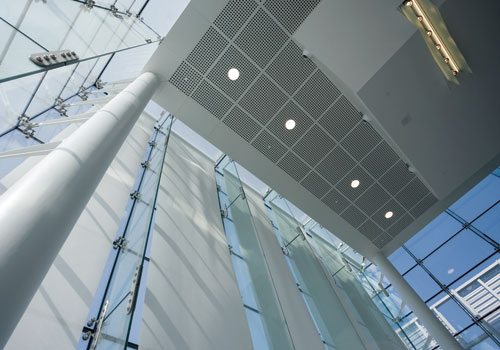Automated Shading and Light Systems
Recognizes overcast, but bright. Sometimes Mother Nature makes it overcast, but bright. In these conditions, the automated default response to cloud cover, which is to raise the shades, would be inappropriate, because the general brightness of the sky could create glare in the workspace. Luckily, these shading systems are equipped with a brightness-override module. A photosensor placed near working level by a window detects the amount of daylight that is streaming through the window and onto the work plane. When illuminance levels exceed a specified threshold, the system automatically adjusts the shade to a predefined position to reduce the risk of excessive brightness in the space.
Compensates for shadow. If a window is in shadow, there is no immediate threat of glare-causing sunlight streaming in through it, even if the day is one of the brightest and sunniest of the season. A shadow-override module considers adjacent structures, such as buildings or trees, and identifies when the façade will be in shadow for some pre-determined minimum amount of time. When the shadow conditions exist, the system raises the shade, so that occupants can enjoy glare-free views.
 |
At the West Midtown Intermodal Ferry Terminal, New York City, automated shading and lighting systems coordinate the presence of daylight and electric light in a space, saving energy. Architect: William Nicholas Bodouva & Associates; photo courtesy of Jim Roof Creative, Inc. |
Daylighting Goal #2: Coordinate Electric Light and Daylight
Daylight control can offer more to an office space than improving productivity and controlling glare, especially when combined with an automated lighting control system. The visual environment of an office space that has windows or some connection to the outdoors is comprised of two types of light: electric light and daylight. While many offices contain these two types of light, few are equipped to coordinate them. This lack of light coordination creates two significant issues in the workspace. First, most buildings today are over-lit because lights are on at full intensity while there is ample daylight streaming in through windows and skylights. Second, a large amount of electric lighting energy is being wasted. Luckily, automated shading and lighting systems can now be specified to coordinate the presence of daylight and electric light, maintaining an optimal visual environment and saving energy.
A comprehensive automated shading and lighting control system leaves little in the visual environment to chance, because everything is controlled. Here's a quick explanation of how the two systems work together. Essentially, target levels of illumination are determined throughout the building. The shading system operates as it would, regardless of whether or not a lighting control system is present, maximizing the amount of daylight in the space, while blocking or diffusing glare-causing direct sunlight. As the solar shades raise and lower automatically, strategically placed photosensors throughout the interior continuously monitor the levels of available daylight and send those readings to the lighting control system. The lighting control system dims, switches off, or brightens the electric lights in the space to maintain the target levels of illumination throughout the building.









